10 Books That Will Change Your Mind about Batsby Zachary Thomas Dodson, October 5, 2015 3:24 PM  Bats are a much-maligned animal. Long thought of as creepy or evil or diseased, a closer look reveals that the wide variety of bat species also possess an amazing array of attributes and perform all sorts of vital ecological roles: from pollinating bananas and mangoes to eating so many insects every night that they save farmers millions in pesticide. I’ve written a book that features bats. It’s called Bats of the Republic (as in the Republic of Texas). It’s set in the 1840s when Texas was its own country for those few strange years, and the main character is a naturalist who travels to Texas and becomes obsessed with documenting all the bat species there (like an Audubon for bats, really). He makes camp outside of a cave and creates many drawings of bats, featured in the book. Bats are a much-maligned animal. Long thought of as creepy or evil or diseased, a closer look reveals that the wide variety of bat species also possess an amazing array of attributes and perform all sorts of vital ecological roles: from pollinating bananas and mangoes to eating so many insects every night that they save farmers millions in pesticide. I’ve written a book that features bats. It’s called Bats of the Republic (as in the Republic of Texas). It’s set in the 1840s when Texas was its own country for those few strange years, and the main character is a naturalist who travels to Texas and becomes obsessed with documenting all the bat species there (like an Audubon for bats, really). He makes camp outside of a cave and creates many drawings of bats, featured in the book.He’s a bat lover, and I hope the book reveals why we all should be. To that end, I’ve put together a list of other books that reveal these fascinating creatures and their essential role in the ecology of the planet and human activities. There’s never been a more important time to pay attention to bats. White Nose Syndrome is a relentless new disease that has devastated the North American bat population in recent years. White fungus appears on the faces and wings of hibernating bats, causing them to wake up in the middle of winter when food sources are scarce. The mortality rate at the caverns where the disease is discovered often approaches 100%. Over 6 million bats have died since 2006. This ecological disaster is the most precipitous decline of wildlife in a century and has wide-ranging implications for the environment, farming, and biodiversity.There are many ways you can help, but a first great step is learning more. Here are some excellent bat books to begin with. “In Praise of Bats” essay in the book The Moon by Whale Light by Diane Ackerman This is a great place to start. Ackerman, a lyrical and fluid writer, makes a literary introduction to bats. Her guide into their hidden world is none other than Merlin Tuttle, bat photographer and conservationist, who founded Bat Conservation International. His namesake applies: the man was a bat wizard and did much to champion their cause and work to change people’s negative perception of these fascinating creatures. They visit Bracken Cave, near San Antonio, Texas, the largest colony of bats (and actually the largest concentration of mammals) on the planet. I went when I was doing research for the book, to watch their nightly emergence in the summer. It was beautiful: for over four hours, the bats streamed from the mouth of the cave. It sounded like a waterfall. Ackerman helps set the record straight: how damaging myths about Dracula and rabies have been to bats, and how important they are to us ecologically. A perfect meditation to enter the kingdom of Chiroptera. Dark Banquet: Blood and the Curious Lives of Blood-Feeding Creatures by Bill Schutt This book takes as its subject every creature that lives off of blood as a primary source of food. So: leaches, bed bugs, ticks, and, of course, vampire bats. There are only three species of vampire bats (out of over 1,200 species of bats total — one of the most diverse animal families on the planet), and their reputation is outsized. One of the species feeds exclusively on chickens. Schutt gets into some pretty grisly stuff: a digestion system that processes blood as food is a different thing, and vampire bats indeed have sneaky ways of stalking their prey. But they are, above all, fascinating. And really not creepy at all next to the chapters on the other blood-suckers. Those are creatures to be afraid of. Stellaluna by Janell Cannon This is a great kids’ book that has found wide appeal with lovely drawings and a sweet story. Stellaluna is a baby fruit bat who gets separated from her mother and grows up among the birds. She struggles to adapt to their ways until she meets some fellow bats who reveal that there are other, more bat-like ways to do things. The takeaway is that it’s OK to be strange and different. A good message, coming from bats. Bat Bomb: World War II’s Other Secret Weapon by Jack Couffer OK, this is going to sound like science fiction, but it’s not. During WWII, tasked with coming up with ways to end the war with Japan, a group of scientists, generals, and government officials began to work on a scheme to release clouds of bats over the skies of Japan with incendiary devices attached. The idea was that the bats would roost in buildings, the bombs would go off, and the entire city would catch fire. Their tests were surprisingly and dangerously successful. President Roosevelt was on board. But the plan was eventually shelved in favor of… the atom bomb, and the bats never got to carry out their kamikaze mission. But can you imagine? File under: stuff you can’t make up. Weetzie Bat by Francesca Lia Block OK, so this book is not about bats, but I couldn’t resist with this character! Growing up in a dreamy ’80s Los Angeles with plenty of freaks and geeks around her, Weetzie Bat is a cherished character for those who are or have been (or even have never been, like me) a teenage girl. If you want a quirky trip back to the ’80s, this is the book for you. Again, nothing to do with bats. But they’re making a movie of it, so now might be the time to revisit Punky Brewster’s cooler older sister. Bat Ecology by Thomas H. Kunz and M. Brock Fenton If you’re getting really serious and scientific about bats, this is the ONLY book for you. It’s the bat bible, and just about as thick. It’s tough to parse without a biologist’s vocabulary (all the bats are referred to in their Latinate names, for example), but there are some fascinating papers within. One of the parts I enjoyed most explained (with diagrams) all the methods scientists might use to capture bats, and how to do it yourself, if you were conducting a study. The mechanics of bat pollination, echolocation, behavior, and aerodynamics can all be found here. Interested in “The Consequences of Polyovulation for Life-History Variation among Bats”? This is the book for you. Dune by Frank Herbert OK, Dune isn’t a book about bats either, but it is a sci-fi classic. And it is set in the desert, so it was a big influence on my book, which takes place on an earth that has become a lot more like the planet Arakis. In Dune, bats are the carrier pigeons, and Herbert’s desert people, the Fremen, use them to send long-range messages. In the Illustrated Dune there is a drawing of the scene where Hawat “took a tiny tube, held it beside the Bat’s head and chattered into the tube; then, lifting the creature high, he threw it upward.” The message is imprinted into the bat’s neural pathways and reflected in its song. Someone with a decoding machine can extract the hidden message in the song of the bat. It’s a beautiful idea, but the reality of bats is no less astounding. Recently it was discovered that bats’ songs are complex and contain many markers and variations, rivaled only by whale songs for their complexity and amount of information they carry. They are pitched too high for humans to hear. Batman: The Dark Knight Returns by Frank Miller and Klaus Janson I suppose there’s no way to write this list without mention of Batman. He generally does bats justice, I feel. But the Dark Knight series was a watershed moment in graphic novels. The urban, gritty feel of Dark Knight was 180 degrees from Adam West’s KA-POW! Batman and all the superhero shtick of early comic books. This series marked a serious departure into dark and disturbing themes, definitely meant for adults. My book features many illustrations and graphic devices throughout, and I’ve long thought that graphic novels deserve a place in the pantheon of literature. Serving as inspiration for the more recent Batman films, The Dark Knight will certainly be among those remembered. Like Batman, bats are misunderstood outsiders, but ultimately do much good for humankind! Bats at the Library by Brian Lies Another children’s book, and one in a series: Lies’s bats go everywhere — the beach, the ballgame, the stage. I chose the library because, well, books. But also, bats were recently discovered living in two libraries in Portugal. The librarians have long tolerated them because the bats eat moths that would otherwise threaten to destroy the old and valuable books they are trying to preserve (we’re talking literal bookworms here: they aren’t a good thing for old books!). So, in exchange for cleaning up a bit of guano, the librarians keep the bats around as most useful exterminators. Another instance of bats being incredibly helpful to humans! The Bat-Poet by Randall Jarrell The main character here is a bat. As in Stellaluna, bats are different, and Jarrell makes much of that difference. Here the bat is, well, a bat-poet, and this children’s animal story functions as a sly metaphor on the writing life, and the isolation it can engender. Recommended for poets. Get the edition with illustrations by Maurice Sendak because: illustrations by Maurice Sendak! |
bats
Big Old Tunnel flight 16Jan2017
Close to a million bats emerge from Old Tunnel on the evening of January 16, 2017. This is the first time they’ve showed up on our radar since New Year’s Eve.
Cold-stunned bats Released!
The strongest cold front in years blew through last week and bats in Austin suffered through the cold and windy nights. Many fell, cold-stunned out of their roosts. But kind-hearted people safely contained some and brought them to us for thawing, some bats every day for a week! We filled their bellies with tasty mealworms and had the pleasure of sharing some Holiday spirit with them. And last night it was finally warm enough to release many of them.
This little guy is your bat Jocelyn. He’s a great bat and he would have died if you hadn’t cared enough to rescue him. Thank You!
And thanks to Christie, Christina, Giselle, and Natalie stopping and taking the time to care for those bats you saved. You are Heroes!

Here’s Natalie’s bat flying off into the night to join the few thousand others overwintering under the Congress Avenue Bridge.

26 degrees F!
Freezing cold night last night! Frozen water trough makes this bat (and his friends) unhappy!
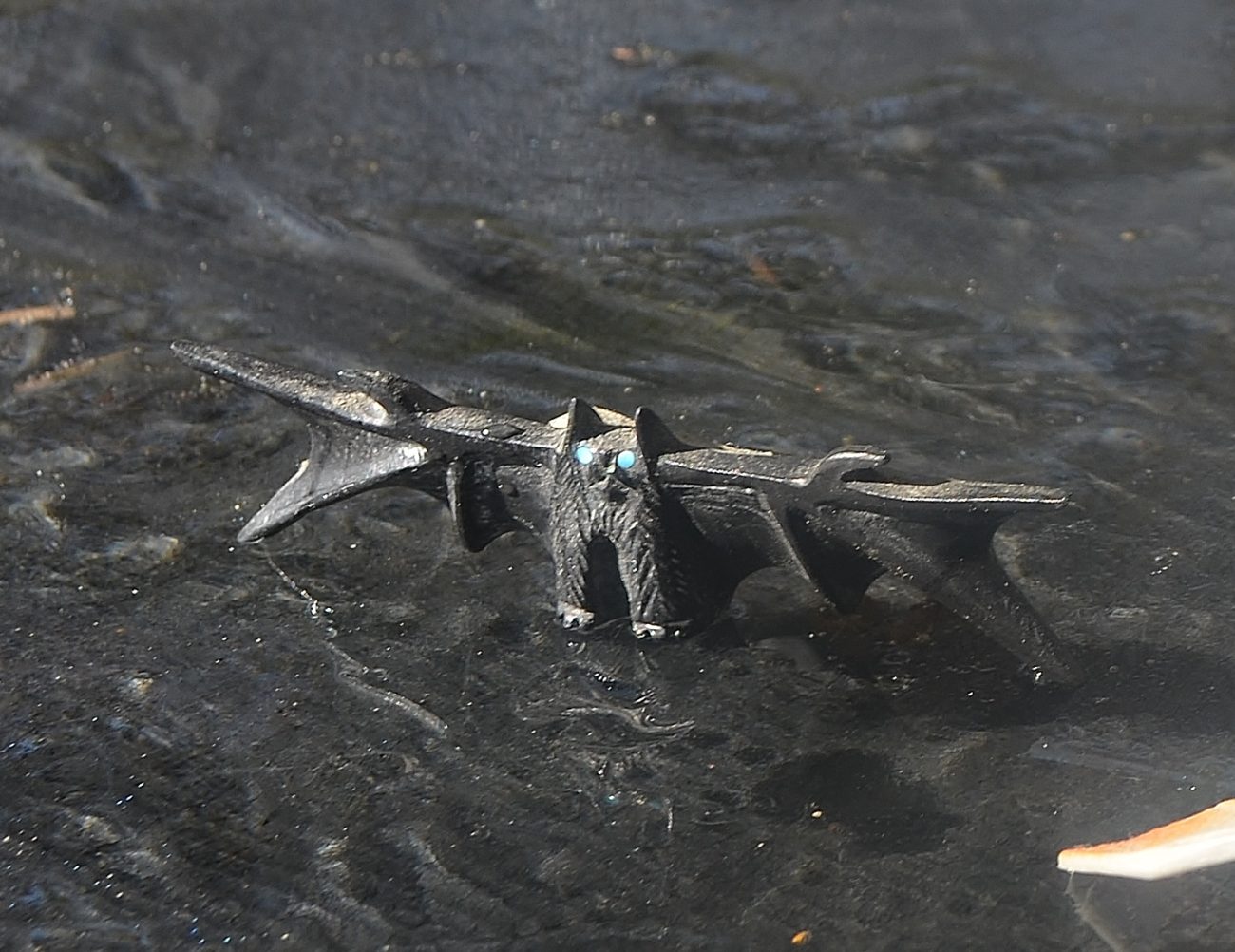


Remember the little ones this Holiday Season!
Dear Bat Friends,
Please remember the little ones as we count our blessings.
Donate Now! to help Gabe the red bat and pups like this free-tailed baby.
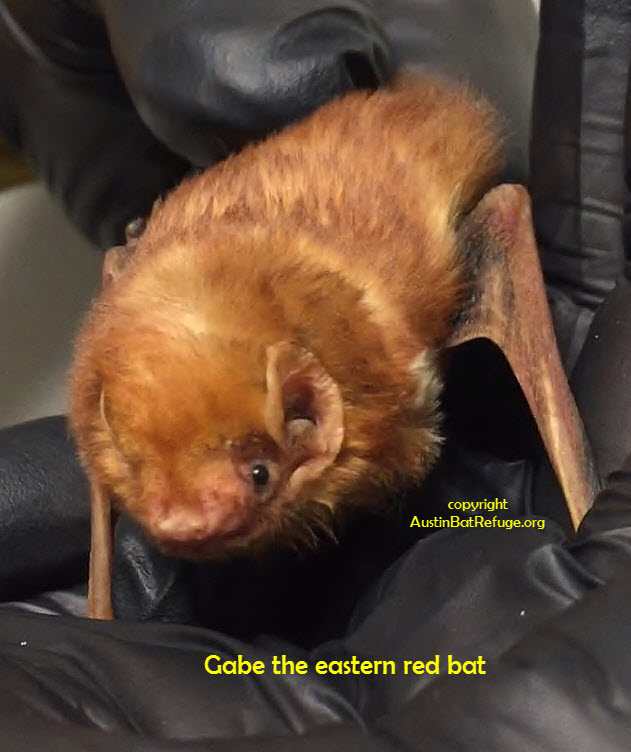

As we enter the holiday season, the world celebrates community, supporting the causes that make the world a better place for all its inhabitants. In our first year, Austin Bat Refuge has already created a center of gravity, attracting donations and a small core of young interns, many or whom will go on to careers in wildlife work. In this season of giving, we ask you to get involved and support Austin Bat Refuge, the only organization in Central Texas caring exclusively for orphaned, injured, and displaced bats.
Your kind donation is critical to bats, our fascinating friends and allies.
Donate Here to help these wonderful, misunderstood beings.
Or write a check and mail to:
Austin Bat Refuge
P.O. Box 49902
Austin, TX 78765
Here are other ways you can show your support:
Sign up for our Newsletter:
Volunteer:
Donate Items:
and yes, as many of you have done, even
Rescue a Bat in Trouble
or simply:
Follow us on Social Media:
Facebook
Twitter
Instagram
Those of you who have brought us an injured bat may have received the following note from us, thanking you for your efforts. We’ll include it here for those of you landing here from social media:
Dear Bat Friend,
Thank you for your kindness in taking the time to rescue the bat you brought to us; we are in awe of the people who have gone so far out of their daily routine to help an animal in trouble.
We hope that you found it a meaningful experience. It meant a great deal to the bat you rescued, and to us; you are part of an ever-growing group of people who care for an animal that many find, at best, unlovable.
Attempting to rescue a bat can seem frightening for people who encounter them, displaced or injured, around their homes or workplaces, and you may even have been ridiculed by those who don’t understand that bats are worthy of care. But you know how rewarding it can be to make the effort to help wildlife.
If it is possible for you to donate, we ask for your financial assistance so that we can continue to serve as a refuge for the injured and orphaned bats that are brought to us by caring people like you.
Your donation will help save the lives of many more little bats in trouble, like the one you saved.
Please Donate Here
And please become a part of our team by joining our Bat Pack!
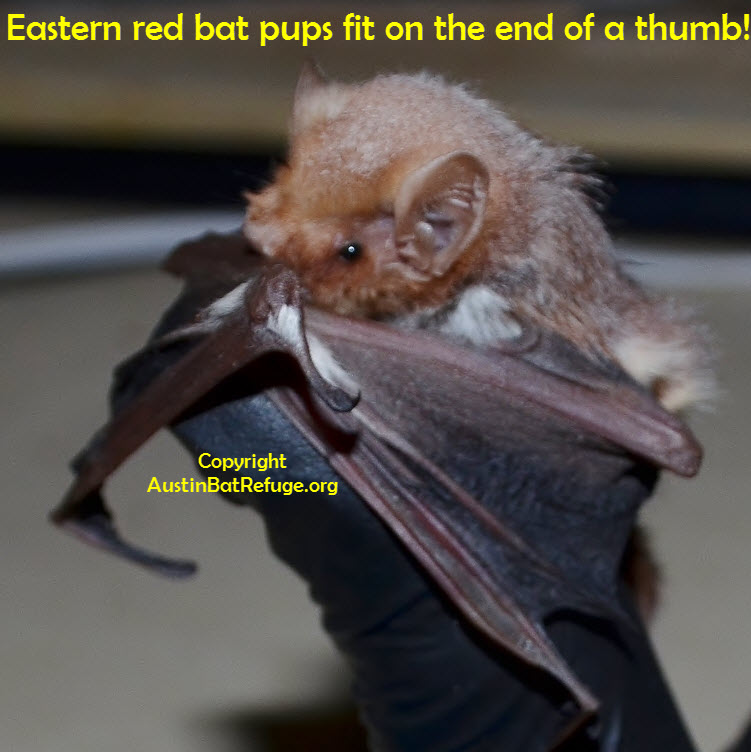
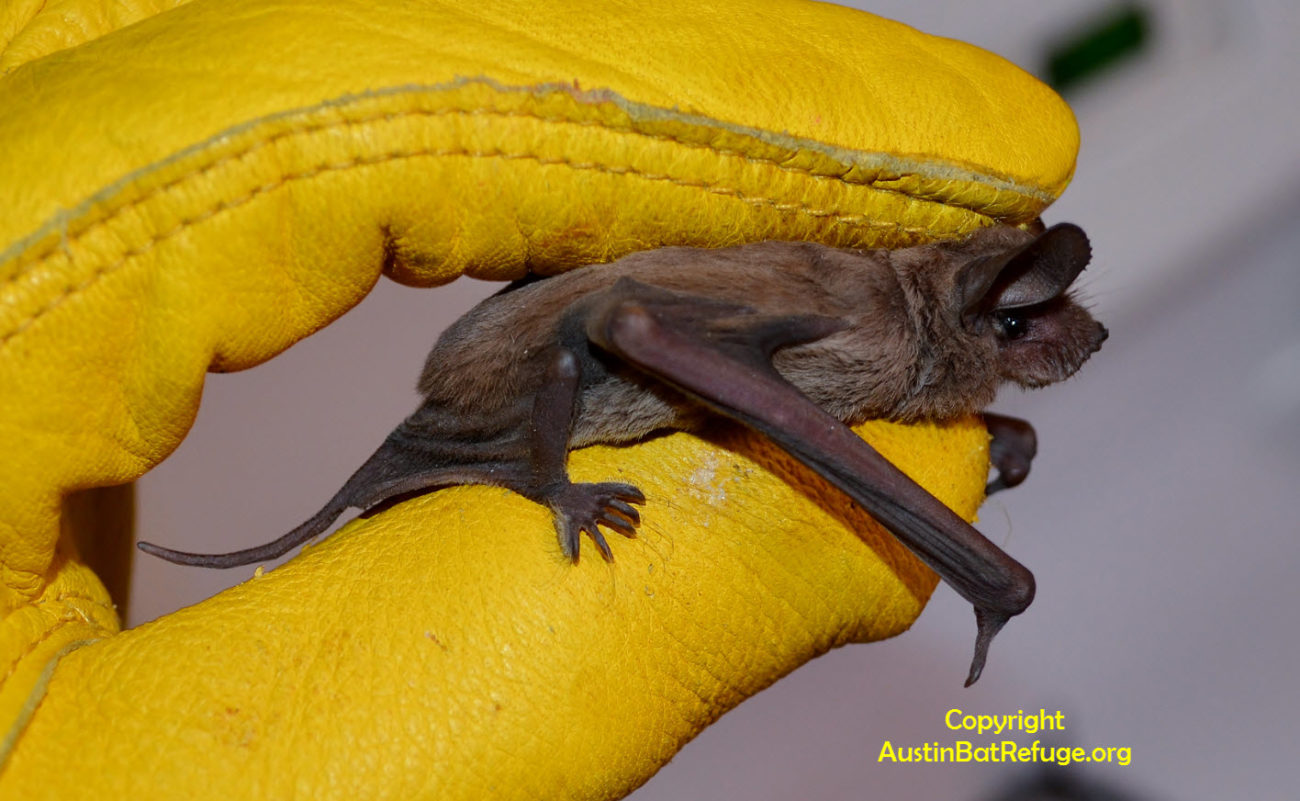

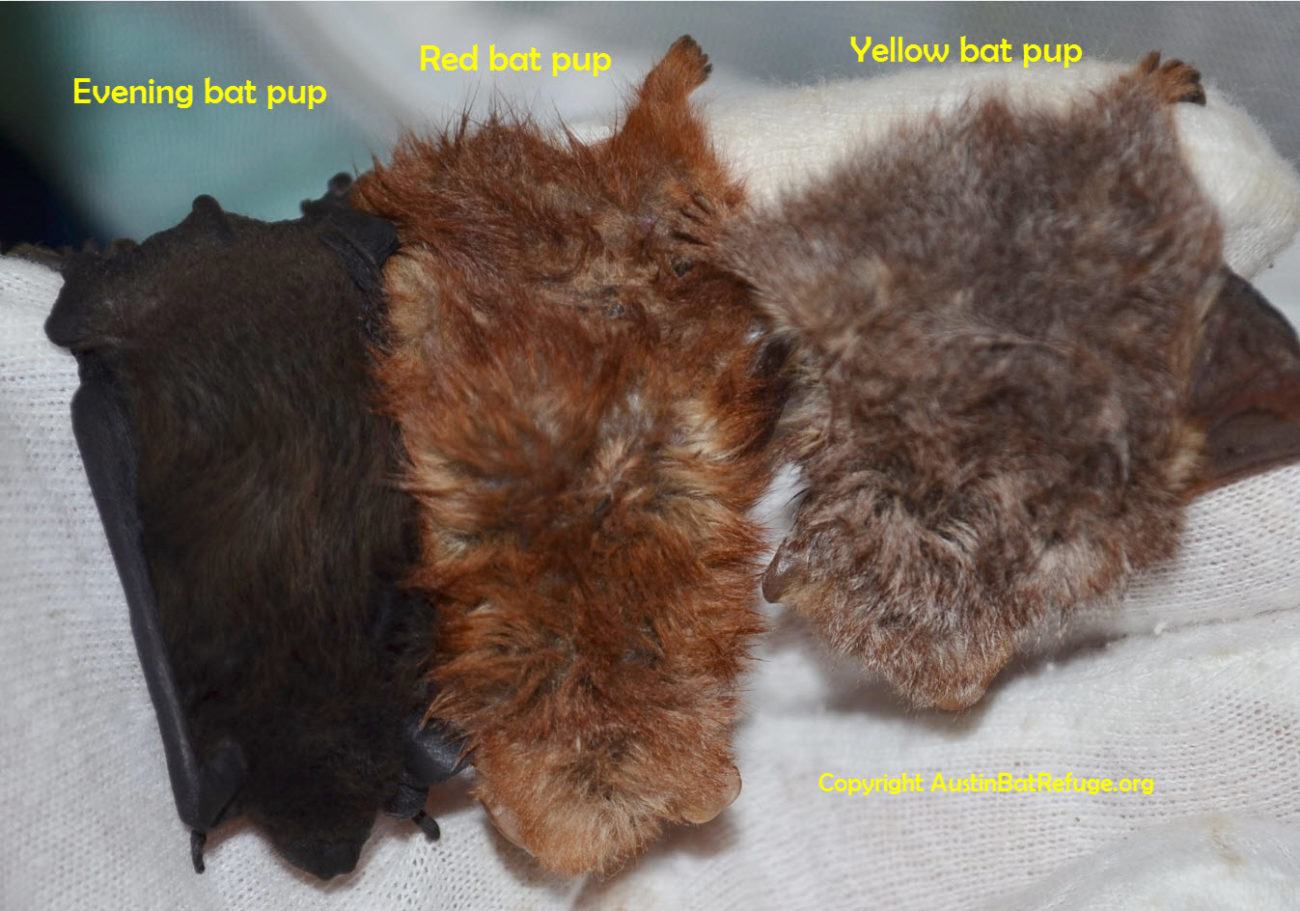
Austin Bat Refuge cares for these bats in a setting that minimizes their stress and fear. Once critical care has stabilized them, they recover in a natural outdoor setting prior to release. If non-releasable, they live a high quality of life with us in the bat gardens or in spacious indoor habitats with plenty of enrichment. Our many visitors have hearts and minds changed by the experience of seeing bats as we care for them. And seeing them in a natural setting is an educational opportunity leveraged by our social media that serves to counter eons of negative myths about bats.
We have cared for close to 750 bats in recent years (139 so far this year), with the majority of them being released back into the wild. If they make it through the first few days, we have a success rate of approximately 86% (which includes those non-releasable individuals living out their lives in our refuge).
Your tax-deductible donation to Austin Bat Refuge will be deeply appreciated, and promptly acknowledged with a document for your tax deduction. We are an all-volunteer, state-permitted 501(c)3 NON-PROFIT organization and receive no government funding. Our costs (not counting volunteer time) can be under $20 for a healthy, quickly-released bat to $200 or more for a bat with a broken bone. Bats that live out their lives in our refuge incur ongoing costs to keep them healthy and well fed.
It is our privilege to care for these orphaned, injured and displaced bats, and your support will give us the ability to do more. Please give us and them a helping hand by mailing a check to our P.O. Box address or contributing to Austin Bat Refuge at this link: Donations
ANY DONATION AMOUNT IS APPRECIATED! And if you can’t give money, please consider donations of volunteer time or items on our Wish List
Thanks so much for caring about these noble, valiant, and amazing flying mammals.
And do please become a part of our team by joining our Bat Pack!
You’ll get our ABR Newsletter with notices for our springtime Bat Walks!
Thanks so much,

Lee Mackenzie
512-695-4116
leemack@austinbatrefuge.org
Dianne Odegard
512-799-8847
Dianne@austinbatrefuge.org
Austin Bat Refuge
http://austinbatrefuge.org
Our radar video on the Today Show.
The Today Show came to visit Congress Ave Bridge and Bracken Cave for a story on Bat Tourism.
Featured is our Mexican free-tailed bat Freida and included is our radar video of the Bracken bats.
Too bad they didn’t credit us for either one of these!
Gabe, the Leader of the Bat Pack
Gabe, the Leader of the Bat Pack, howls to proclaim his dominance over all he surveys!
He wowed over 5,000 students in an on-line Distance Learning event at the Texas Wildlife Association.
Their Halloween annual with our bats, called Bats-a-Billion, is their biggest online event of the year every year.
In addition to Gabe, we brought Buffy (a northern yellow bat), Zonker (an evening bat), and Buddy (a Mexican free-tailed bat).
They are all good bats!
Tri-colored South Austin
Here’s a beautiful tri-colored female that had been roosting in a stairwell landing on the second story of an apartment building in South Austin. She was in the same place for about a week with no sign that she had been able to fly or feed. Her location made her vulnerable to maintenance workers or perhaps a fearful apartment dweller with a broom.
Wildlife lovers Sonja Peterson and Thanh Vo had been checking on her and were worried that she had not seemed to move for a long time. They were relieved to finally see her stretch her wings a few days back, but were concerned that she might be injured and unable to feed herself. So we went to look and spotted her immediately when we pulled up to the building. We plucked her off the wall (with gloves on) and brought her back to check her out in the flight cage.
Her wings were beautiful, no spotting, no tears, no broken bones.

We checked her out under UV light and no florescence showed up that would indicate Pd, the fungus that causes White-nose Syndrome.
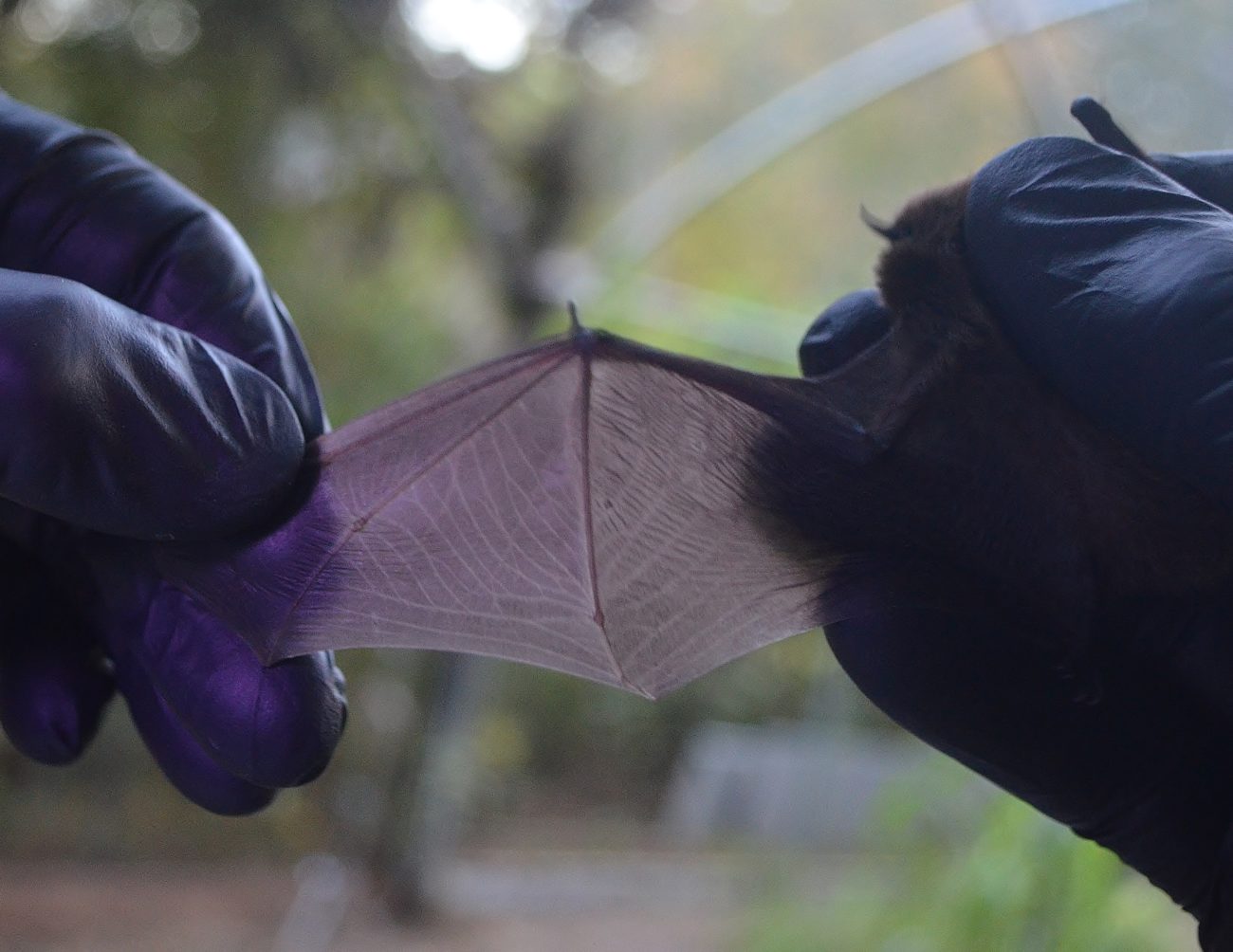
She flew right off when given the opportunity and we watched as she did about six laps around the aviary. This is way more continuous flight than the last tri-colored we took in a few days ago.
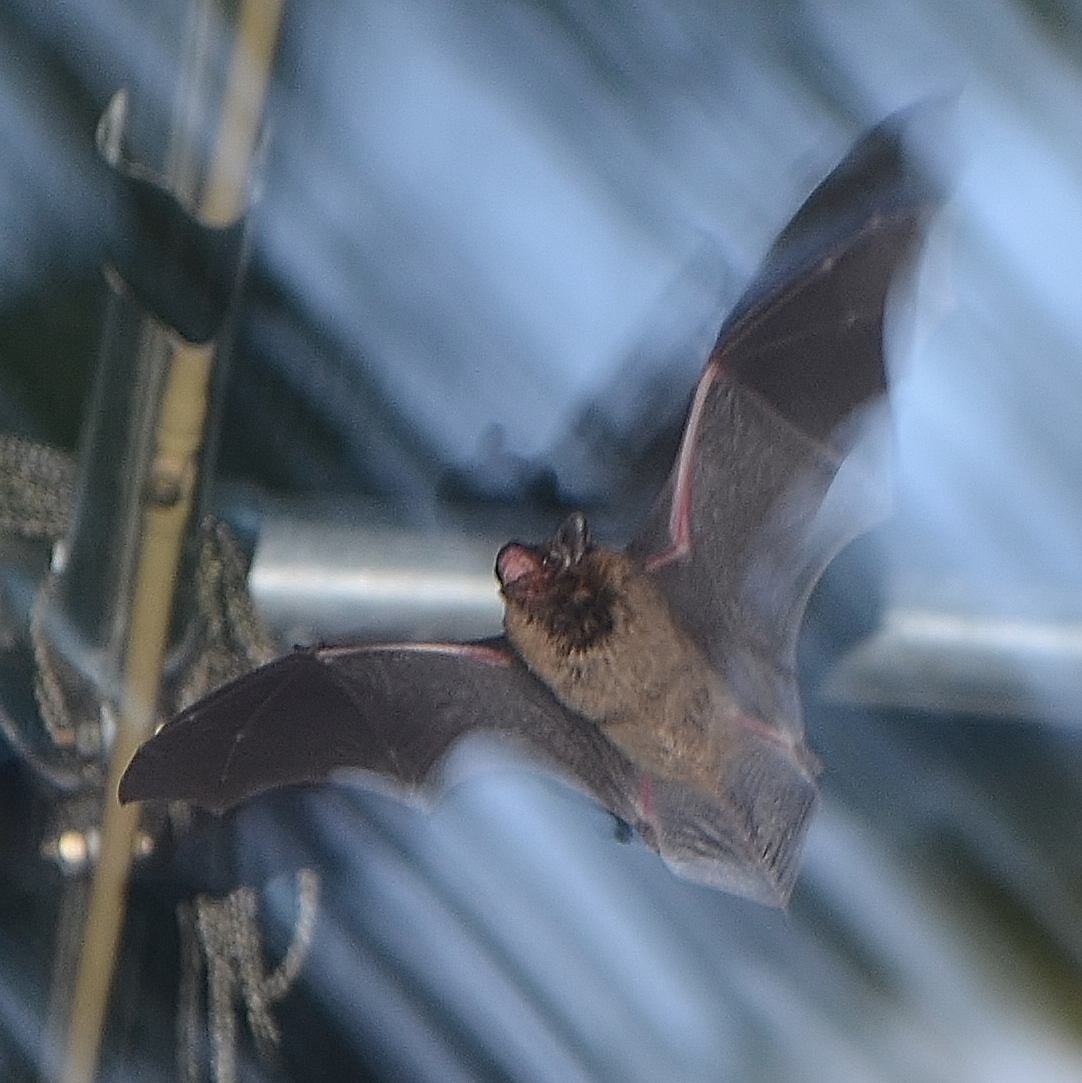
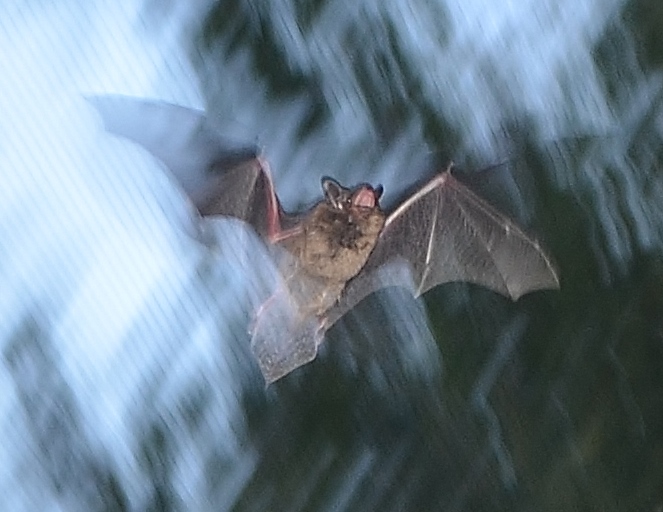
So this leaves us to wonder why she would roost in such an exposed location, vulnerable to any humans walking by or even grackles which could easily spot her against the white stucco.
Most of our tri-colored bats come to us from the upper levels of apartment buildings that have open-ended corridors leading to the various apartments. We think the bats consider these to be open-ended caves and feel quite at home there. At this time of year both sexes of tri-coloreds should be swarming at cave mouths and mating, the females storing sperm for spring births. Is it possible this bat is misplaced and hanging around wondering where the guys are?
We’ll feed her up and then bring her back to the same area and hope she finds a real cave to get her back on track.
Check out our local species info page: http://austinbatrefuge.org/tri-colored-bat/
Sonja and Thanh are doing great work with the feral cats around their apartment. Thanks to them this bat and all other wildlife will fare much better in their area. Thanks for caring Sonja and Thanh!
Zach Dodson – 10 Books That Will Change Your Mind about Bats
Zach Dodson is an Austin-born writer/artist/illustrator
Author of Bats of the Republic, a wonderful out-of-the-box creation
Buy it – and look inside the dust cover!
Here is his blog about some books that influenced his love of bats.
PowellsBooks.Blog
Authors, readers, critics, media − and booksellers.
Happy free-tail
This free-tail is so happy to be flying again and catching moths around the blacklight!
Soon to be back in the wild skies.
Just look at that smile!



